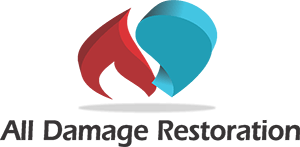
After a fire, the focus often shifts quickly to rebuilding and repairing physical damage. However, an equally critical concern is Mold Prevention, especially considering the increased humidity and moisture levels that fires can cause. In this comprehensive guide, we’ll explore the essential steps to manage humidity and mitigate mold risks post-fire, and how All Damage Restoration’s expertise can be invaluable in ensuring your home remains mold-free and safe.
The Link Between Fire Damage and Mold Growth
The Link Between Fire Damage and Mold Growth
The aftermath of a fire presents numerous challenges, one of which is the increased risk of mold growth due to heightened moisture levels. Understanding this link is essential in Mold Prevention strategies following a fire incident. Here, we delve deeper into how fire-related activities contribute to conditions favorable for mold development and the necessary steps to mitigate these risks.
Impact of Firefighting Efforts on Humidity
– – Water as a Double-Edged Sword: While water is crucial for extinguishing fires, it can significantly increase indoor humidity levels. The gallons of water used in firefighting efforts often seep into building materials and furnishings, creating a damp environment where mold thrives.
– Immediate Aftermath Concerns: Post-fire, as the focus is on assessing structural damage, the underlying issue of increased moisture can go unnoticed, setting the stage for mold growth.
Mold Growth Post-Fire: A Silent Threat
– Rapid Development in Moist Conditions: Mold can begin to grow within 24-48 hours in damp environments. Post-fire settings, with their mix of soot, ash, and moisture, provide an ideal breeding ground for various mold species.
– Compounded Health Risks: The presence of mold post-fire adds to the health hazards, particularly for individuals with respiratory issues. The combination of smoke, soot, and mold spores can exacerbate lung and skin conditions.
Addressing Hidden Moisture
– Challenges in Detection: Post-fire, moisture can hide in less visible areas like behind walls, under floors, or in ceilings. This hidden moisture is a significant concern for Mold Prevention.
– Professional Assessment: Utilizing professionals for a thorough inspection post-fire is crucial. They employ specialized equipment to detect and measure moisture levels even in hidden areas, ensuring no damp spots are overlooked.
Preventing Mold Growth After Fire
– Timely Intervention: Quick response in addressing moisture and dampness post-fire is key in preventing mold. It’s essential to start the drying process as soon as possible.
– Professional Mold Prevention Techniques: Experts in fire damage restoration understand the nuances of mold growth post-fire. They apply specific techniques to ensure the property is not only dried but also treated for potential mold growth.
Understanding the intrinsic link between fire damage and subsequent mold growth underscores the importance of immediate and effective Mold Prevention measures post-fire. Addressing the moisture issue promptly and thoroughly is essential to safeguarding the property from further damage and ensuring the health and safety of its occupants.
Professional Restoration and Mold Prevention
In the wake of fire damage, professional restoration services play a pivotal role in Mold Prevention. Their expertise not only lies in repairing the damage caused by fire and water but also in implementing strategies to prevent mold infestations, which can arise due to increased moisture levels.
Role of Professional Restoration in Mold Prevention
– Comprehensive Moisture Elimination: Professional teams use advanced equipment like industrial dehumidifiers and air movers to thoroughly remove moisture from the fire-affected areas. This step is crucial in preventing mold growth.
– Targeting Hidden Moisture: Experts are trained to identify and address moisture in hidden areas – behind walls, under floors, or in ceilings – places where mold is likely to develop unnoticed.
Advanced Techniques for Mold Prevention
– Mold Inhibitors: Post water extraction, professionals often use mold inhibitors to treat areas susceptible to mold growth. These inhibitors provide a protective barrier that prevents mold spores from taking root.
– Proactive Measures: Restoration experts can also recommend proactive measures such as improving ventilation or adjusting the HVAC settings to maintain an environment less conducive to mold growth.
Importance of Timely Intervention
– Reducing Long-Term Risks: Prompt and professional intervention after a fire not only addresses immediate repair needs but also reduces the long-term risk of mold-related issues.
– Health and Safety: By ensuring complete moisture removal and taking preventive steps against mold, restoration services help maintain the health and safety of the building’s occupants.
Collaboration with Homeowners
– Education and Guidance: Professional restoration services also play an educational role, advising homeowners on signs of mold growth and how to maintain an environment that discourages mold proliferation.
– Customized Mold Prevention Plans: Based on the specific needs and conditions of the property, restoration experts can develop a customized mold prevention plan, offering long-term solutions to the homeowners.
In summary, professional restoration services are not just about repairing the damage; they are about safeguarding the future of your property. By addressing the increased moisture levels caused by fire-fighting efforts and applying expert **Mold Prevention** techniques, they help ensure that your home remains safe, healthy, and free from mold infestations.
Strategies to Prevent Mold Post-Fire
Regular Monitoring and Maintenance
– Keep an Eye on Humidity: Regularly monitor humidity levels in your home to ensure they remain within a safe range.
– Routine Inspections: Regularly inspect your home for signs of mold, paying particular attention to areas that were most affected by water during firefighting efforts.
Rebuilding with Mold Prevention in Mind
– Use of Fire-Resistant Materials: When rebuilding, consider using fire-resistant materials that are less likely to harbor mold.
– Smoke Alarms and Safety Measures: Ensure that smoke alarms are functional and consider consulting a professional for advice on mold-resistant construction techniques.
Post-fire recovery is a multifaceted process where Mold Prevention plays a crucial role. Understanding the relationship between fire damage, increased humidity, and mold growth is key to a successful recovery. With the support of All Damage Restoration, you can effectively manage these risks, ensuring your home is not only rebuilt but also protected from potential mold-related health hazards.
For expert advice and services in mold inspection and removal, visit mold removal services.
